Spicy Cumin Noodles with Salmon
This post contains affiliate links.
Chewy udon noodles get tossed with garlic, ginger, chilies, ground cumin, Sichuan peppercorns and Asian greens in a delicious savory-sweet sauce with a kick of heat! Crowned with a perfectly pan-fried salmon fillet, this Spicy Cumin Noodles dish is weeknight comfort food at its best!
You may have heard of or even tried the popular spicy cumin noodles with lamb from Xi’an Famous Foods in New York City.
This dish is not it or inspired by it. It’s an easy to make weeknight udon noodles stir-fry that is full of wonderful aromas and spices! It’s also more nutritious thanks to using salmon instead of lamb and not as heavily spiced or spicy from chili oil. (Though I highly recommend drizzling some on top!)
We have:
- Chewy and perfectly slurpable udon noodles.
- Fragrant aromatics like garlic, ginger, red chilies and spring onion.
- Asian greens. Use any type you love!
- Spices like freshly toasted numbing hot ground Sichuan peppercorns and ground cumin.
- A delectable savory-sweet spicy sauce which is SOOOO YUM!!
- And it’s topped with a perfectly pan-fried crisp-on-the-outside and tender, wonderfully flaky, and cooked to your liking salmon fillet!
This Spicy Cumin Noodles with Salmon stir-fry is simply GLORIOUS! It’s an addictive and rewarding comforting noodles weeknight meal for one. I think you’re going to love it!
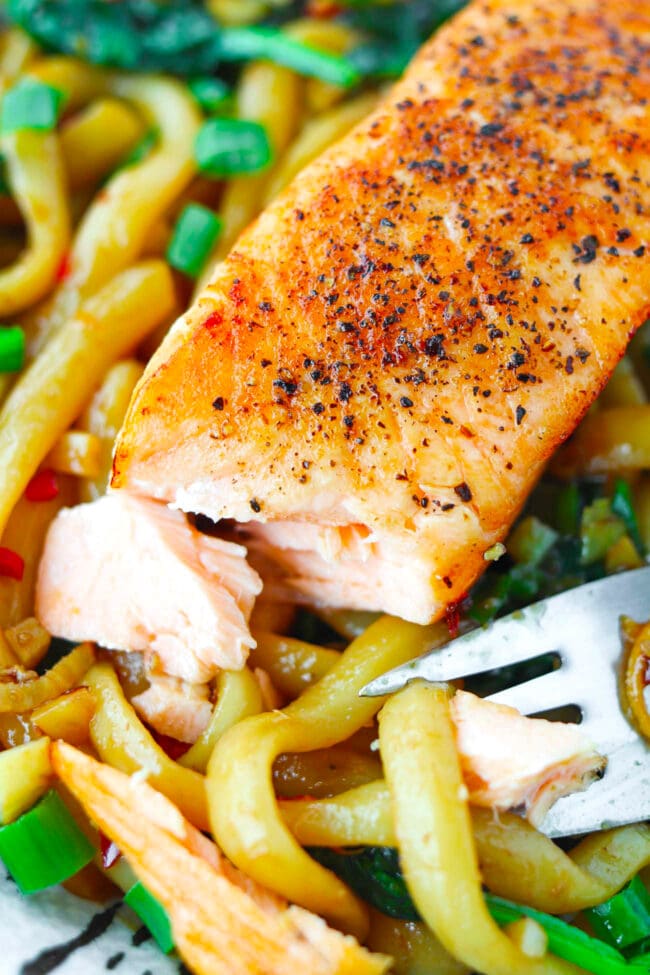
Why This Recipe Works
- Quick and easy to make. The entire dish comes together in about 30 minutes.
- Adjustable quantity! The recipe as written is a hearty meal for one, but you can easily double the ingredients to make dinner for two.
- Flexible. Use your choice of Asian greens or other leafy greens. If you’re not a fan of salmon, swap for your favorite firm fish fillet or use shrimp for the protein instead.
- Adjustable spice level. Amp up the heat by using more red chilies and crushed red pepper flakes. Or tone down the chili action if needed.
- Comfort food at its best! It’s a comforting and filling noodles dish that will leave you satisfied!
Ingredient Notes and Substitutes

- Udon Noodles: I used vacuum sealed packs of pre-cooked udon noodles. They can be found online and at Asian or Japanese supermarkets. You can use frozen udon noodles too or par-cooked udon noodles from the fridge section. Feel free to swap for a vacuum sealed pack of Shanghai noodles, ramen, knife-cut or any other type of noodles you like. You can also use fresh flat wide rice noodles (like the ones used in chow fun or pad see ew) if you prefer. While you can use dried udon in a pinch, note that it won’t have the same bouncy and chewy texture.
- Salmon Fillet: Boneless but skin-on. The skin keeps the flesh tender during cooking and reduces the chances of overcooking the fish. However, you can remove and discard it just before plating if you’re not a fan of eating fish skin.
- Kosher Salt and freshly cracked Black Pepper: To season the salmon to taste.
- Aromatics: A classic combination in Chinese cooking – spring onion (scallion/green onion), garlic, ginger and fresh red chilies. I used Thai Bird’s Eye red chilies, but any hot red chilies that you can get in your area will work just fine. Adjust the quantity of chilies to taste based on your heat level preference.
- Asian Greens: I used Chinese baby spinach here, but regular Chinese spinach, bok choy, choy sum, Chinese broccoli (‘gai lan’) will all taste great in these spicy cumin noodles. Be sure to slice off and discard any fibrous spinach stems if needed. Peel the Chinese broccoli stem part (if using) before slicing.
- Sichuan Red Peppercorns: I used whole Sichuan red peppercorns, which you can find in Asian supermarkets or most large supermarkets that stock international ingredients. You’ll need to remove the twigs and black seeds as only the husks carry the numbing spice flavor.
- Canola Oil: Or use any other neutral cooking oil.
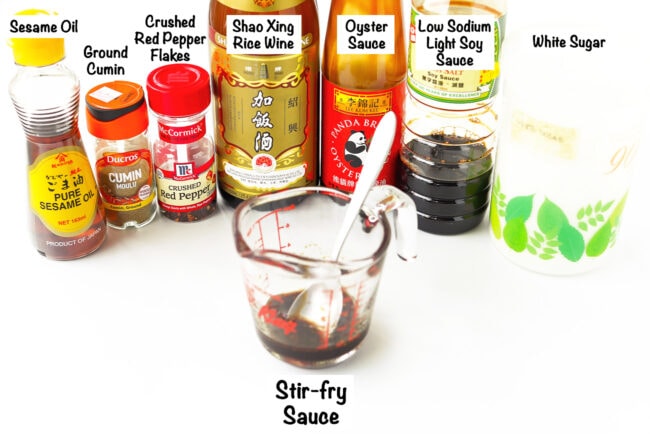
- Low Sodium Light Soy Sauce: Low sodium so that we have better control over the salt level.
- Shao Xing Rice Wine: A fragrant Chinese cooking wine available at Asian supermarkets and online. Substitute with dry sherry if unavailable.
- Oyster Sauce: An Asian pantry staple. It’s a thick and sticky sauce with a sweet and savory flavor. It’s full of umami and does not taste strongly of oysters. I like using Lee Kum Kee’s Panda brand oyster sauce in my home.
- Sesame Oil: For toasted sesame flavors and aroma.
- White Sugar: Feel free to adjust the quantity to taste to balance out the spice level to suit your taste.
- Crushed Red Pepper Flakes: Use more or less to taste depending on how spicy you like your noodles.
- Ground Cumin: Be sure to use roasted ground cumin as it has a more pronounced flavor than unroasted ground cumin. If you have unroasted whole cumin seeds, you can toast them with the Sichuan peppercorns in a pan and grind both using a mortar and pestle. Sprinkle this mixture onto the noodles in the wok directly.
Full ingredient list and amounts are in the recipe card below.

How to Make Spicy Cumin Noodles with Salmon
1. Pan-fry the salmon. Use a small or medium nonstick skillet and pan-fry both sides until the flesh exterior is crisp and golden brown and the inside is cooked to your liking. Transfer to a clean plate to rest.
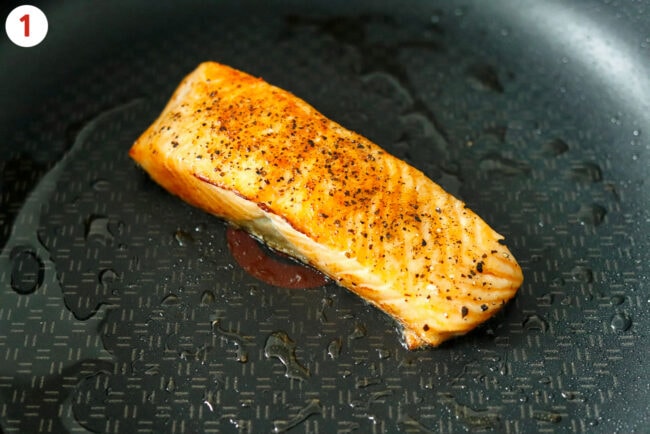
2. Prepare the noodles. Bring a small pot of water to a boil and place the noodle cake in it. Use tongs to grab onto the cake and gently shake to loosen the strands. Once loosened and tender, drain into a colander and run cold water on top to prevent sticking. (If using dried or frozen noodles, prepare according to package instructions.)
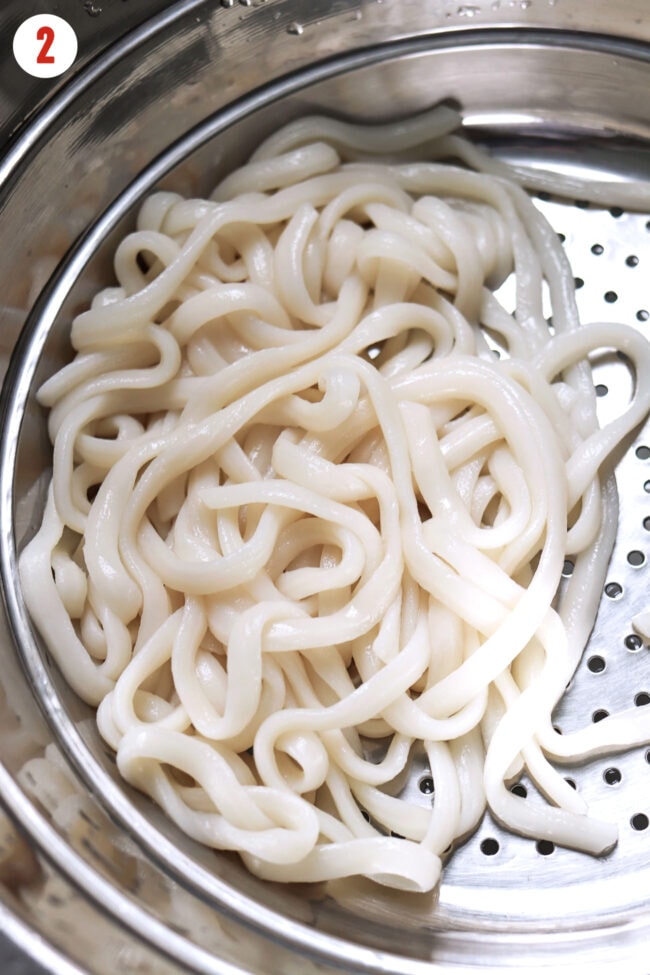
3. Stir-fry the aromatics. In a large wok, heat oil and stir-fry the spring onion white and light green parts and ginger for a few seconds. Then add the garlic and red chilies and stir-fry until fragrant.
4. Stir-fry the Asian greens. Just until starting to wilt and soften.
5. Add the noodles, sauce and Sichuan red peppercorns. Stir-fry continuously until the noodles are evenly coated with the sauce and everything is evenly combined.
6. Toss through the spring onion dark green parts. Switch off the heat.
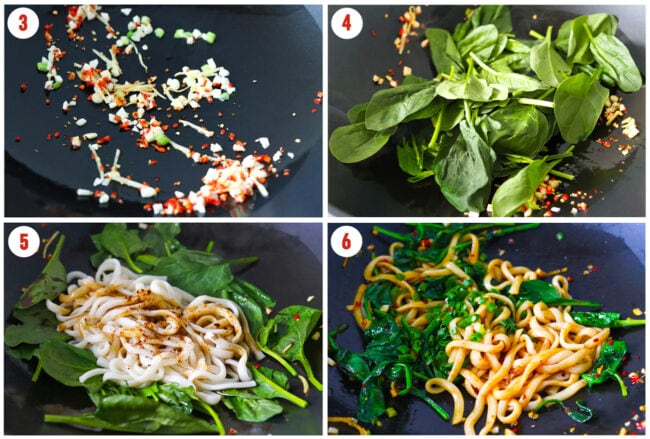
Serve! Transfer the spicy cumin noodles stir-fry to a plate or bowl. Peel off and discard the skin of the salmon fillet if you like and place on top of the noodles. Garnish with extra spring onion and enjoy!

Full detailed instructions are in the recipe card below.
Cook’s Tips
- Use ground Sichuan peppercorn to save time. It’ll still taste great if you’re in a pinch and can be found in most large supermarkets or online.
- Use a wok or a heavy bottomed deep edged frying pan. Although a wok works best to give the noodles the signature ‘wok hei’ (breath of the wok) flavor, a large heavy bottomed deep edged frying pan will work well too.
- Drizzle with your favorite chili oil. Just a little of your favorite store-bought or homemade Chinese chili oil (with flakes and seeds) goes a long way. It’ll make these noodles taste a little extra spicy and special!
- Avoid using dried noodles if possible. The dish won’t be as satisfying because dried udon noodles won’t have the same chewy and bouncy texture as fresh, frozen or vacuum sealed packs of udon noodles.
- Double the recipe. To make 2 servings, simply double all the ingredients. (Click the ‘2x’ button in the recipe card below to show double the ingredients amounts). Use a large enough wok or pan for the cumin noodles stir-fry. Or cook in two batches if your wok isn’t very large.
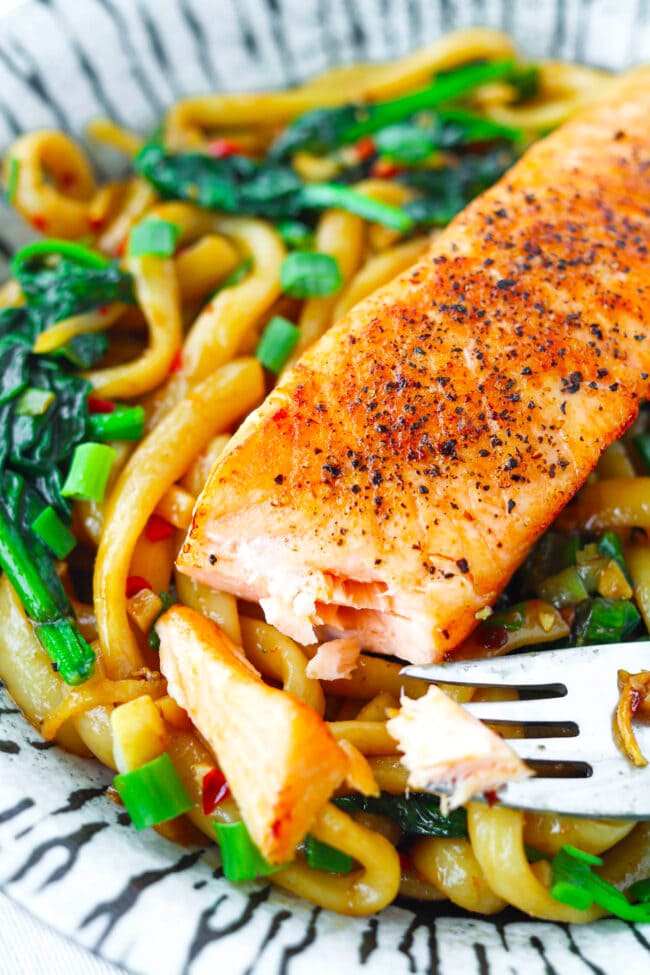
FAQs
It is not spicy hot like ground cayenne. Instead, it boasts warm and earthy flavors with a mild hint of citrus. It has a strong smell and toasting cumin seeds brings out the flavors and aroma.
Although udon noodles taste best right after stir-frying, stir-fried udon noodles can be reheated in the microwave. Reheat on high for 1-2 minutes, stopping to stir every 30 seconds, until hot throughout.
Udon noodles are made of wheat flour as the primary ingredient, water, and salt. Therefore, they are not gluten-free.
Variations
- Use another type of fish. Cod, pollock, halibut, mahi-mahi, tuna, tilapia, sea bass or other firm fish can also be used instead of salmon. You can also use sautéed shrimp. Season with salt and pepper and cook in a little oil first in a separate pan. Or the same wok you’ll use for the noodles and transfer to a clean bowl. Add back into the wok when you add the noodles and sauce.
- Use different veggies. Any type of Asian greens will work here. However, you could also use regular baby spinach or baby kale and it’ll still taste delicious.
- Make it gluten-free. Use gluten-free soy sauce, oyster sauce, and dry sherry instead of Shao Xing rice wine. Swap the udon noodles for fresh flat wide rice noodles, thin rice vermicelli (like the one I’ve used for spicy curry laksa), or other gluten-free noodles of your choice.
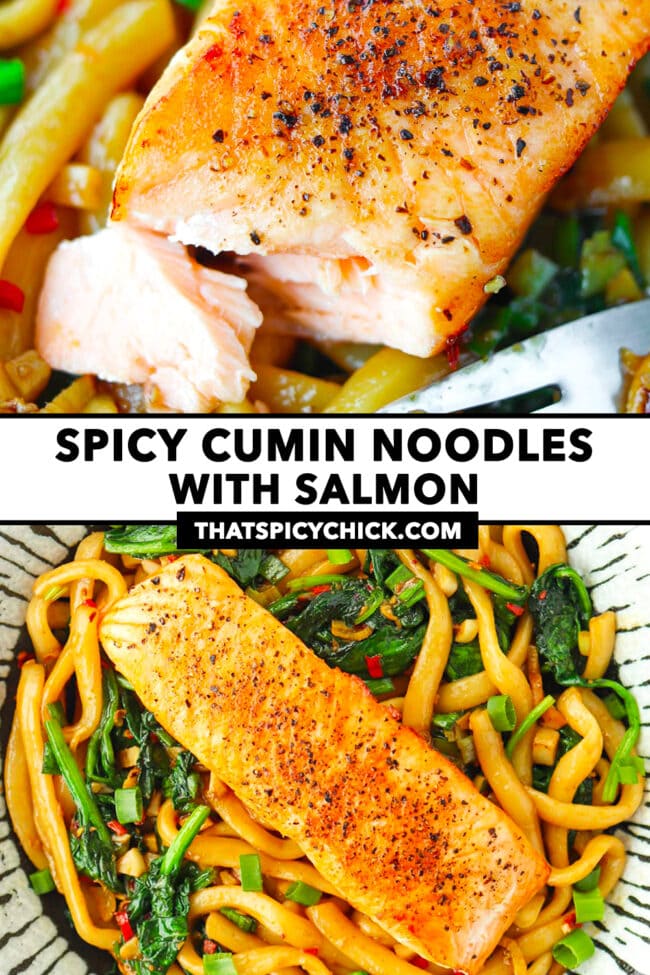
More Delicious Stir-fried Noodles
- Shanghai Style Fried Noodles
- Char Kway Teow (Malaysian Flat Wide Rice Noodles Stir-Fry)
- Thai Eggplant Noodles
- Pad See Ew
- Chicken Chow Fun
- Or browse the entire Noodles recipe collection.
MADE THIS RECIPE? If you make this recipe, leave a comment below and let me know how you liked it! Take a photo and tag it with @thatspicychick on Instagram and hashtag it #thatspicychick and I’ll be sure to share your masterpiece!
STAY CONNECTED! You can also follow me on Pinterest, Facebook or Instagram. Sign up for my email list to get my latest recipe in your inbox weekly!
PrintSpicy Cumin Noodles with Salmon
Chewy udon noodles get tossed with fragrant aromatics, ground cumin, Sichuan peppercorns, and Asian greens in a delicious savory-sweet and spicy sauce! Crowned with a perfectly pan-fried salmon fillet, these Spicy Cumin Noodles is weeknight comfort food at its best!
- Prep Time: 15
- Cook Time: 15
- Total Time: 30 minutes
- Yield: 1 1x
- Category: Dinner
- Method: Stir-fry
- Cuisine: Sichuan-inspired
Ingredients
For the Spicy Cumin Noodles:
- 7 ounces / 200 grams Udon Noodles (I used a vacuum sealed pack – note 1)
- 2 Garlic Cloves – roughly chopped
- 1 Spring Onion (Scallion/Green Onion) – finely chopped, white and light green parts separated from dark green parts
- 1 – 3 fresh Red Chilies (Thai Bird’s Eye or any other small hot red chilies), to taste – finely chopped
- ½-inch piece Ginger – pieced and julienned (about 1 tablespoon of julienned ginger)
- 1 cup sliced Asian Greens (Chinese baby spinach or regular Chinese spinach, bok choy, choy sum, Chinese broccoli – ‘gai lan’) – fibrous stems removed if using spinach
- ¼ TSP Sichuan Red Peppercorns (note 2) – twigs and black seeds removed (or substitute with ground Sichuan peppercorns)
- 2 TBLS Canola Oil (or other neutral cooking oil)
For the Sauce:
- 1 TBLS Low Sodium Light Soy Sauce
- ½ TBLS Shao Xing Rice Wine (or substitute with dry sherry)
- 1 TBLS Oyster Sauce
- 1 TSP Sesame Oil
- ½ TSP White Sugar
- ¼ TSP Crushed Red Pepper Flakes, to taste
- ¼ TSP Ground Cumin
For the Salmon:
- 1 (about 120 grams/4–5 ounce) Salmon Fillet, boneless, skin-on (note 3)
- ⅛ – ¼ TSP Kosher Salt, to taste
- ⅛ TSP freshly cracked Black Pepper, to taste
- ½ TBLS Canola Oil
Instructions
Prep:
- Prepare the fresh and dry ingredients: Chop/slice the garlic, spring onion, fresh red chilies, ginger, and Asian greens as indicated in the ‘Ingredients’ section. Toast the Sichuan red peppercorns for a minute in a skillet until aromatic. Use a mortar and pestle to grind into a coarse powder and set aside. (Note: If using whole cumin seeds, toast with the Sichuan peppercorns and grind too. Add both into the wok in step 4.)
- Make the sauce: Whisk together the low sodium light soy sauce, Shao Xing rice wine, oyster sauce, white sugar, ground cumin, crushed red pepper flakes and sesame oil in a measuring cup or small bowl until thoroughly combined.
- Prepare the salmon: Remove the salmon fillet from the packaging it came in and gently pat-dry with paper towels. Place on a plate and season with kosher salt and freshly cracked black pepper to taste.
For the Spicy Cumin Noodles with Salmon:
- Pan-fry the salmon: Heat ½ tablespoon canola oil in a medium skillet over medium-high heat. Once hot, place the seasoned salmon fillet skin side down in the skillet and allow to sear for 1 minute. Turn the fillet over and cook for 1-2 minutes. Use tongs to turn the fillet onto its side and cook each side for 15-20 seconds or until crisp and browned too. Once cooked to your liking, switch off the heat and transfer to a clean plate to rest.
- Prepare the noodles: Bring a small pot of water to a boil and place the noodle cake in it. Use tongs to grab onto the cake and gently shake to loosen the strands. Once loosened and tender, drain into a colander and run cold water on top to prevent sticking. (Note: If using dried or frozen noodles, cook according to package instructions.)
- Stir-fry the aromatics: Heat 2 tablespoons canola oil in a large wok (or heavy bottomed deep edged frying pan) over high heat. Once hot, lower the heat to medium-high and add the spring onion white and light green parts and ginger. Stir-fry for 20 seconds until you can smell the ginger, then add the garlic and red chilies and stir-fry for another 20 seconds until fragrant.
- Add the Asian greens: Add the Asian greens and stir-fry for 30 seconds or until just starting to wilt and soften.
- Add the noodles, sauce and Sichuan red peppercorns: Add the noodles and pour the sauce over them. Sprinkle the ground Sichuan peppercorn on top. Stir-fry for 1 minute, until the noodles are evenly coated with the sauce and the Asian greens are crisp tender.
- Toss through spring onion: Toss through most of the spring onion dark green parts (reserve a few pieces for garnish) and switch off the heat.
- To Serve: Transfer to a plate or bowl. Peel off and discard the skin of the salmon fillet if desired and place on top of the noodles. Garnish with the reserved spring onion dark green parts and serve immediately.
Notes
- Udon Noodles. I used vacuum sealed packs of pre-cooked udon noodles. They can be found online and at Asian or Japanese supermarkets. You can use frozen udon noodles too or par-cooked udon noodles from the fridge section. Feel free to swap for a vacuum sealed pack of Shanghai noodles, ramen, knife cut or any other type of noodles you like. You can use fresh flat wide rice noodles (like the ones used in chow fun or pad see ew) if you prefer too. Dried udon can be used in a pinch, but note that it won’t have the same bouncy and chewy texture.
- Sichuan Red Peppercorns: These have a numbing hot flavor and make your tongue buzz a little. Find them at an Asian or Chinese supermarket or online. Alternatively, you can use ground Sichuan peppercorn to save time. It can be found in most large supermarkets that are well-stocked with international ingredients.
- Salmon. Cod, pollock, halibut, mahi-mahi, tuna, tilapia, sea bass or other firm fish can also be used instead of salmon. You can also use sautéed shrimp. Season with salt and pepper and cook separately in a pan first. Add to the wok when you add the noodles and sauce and toss through.
- Adjust the spice level to taste. Use more or less fresh red chilies and crushed red pepper flakes based on your heat level preference. Feel free to also adjust the amount of Sichuan red peppercorns and ground cumin to taste.
- Make it gluten-free. Use a gluten-free soy sauce, oyster sauce, and dry sherry instead of Shao Xing rice wine. Swap the udon noodles for fresh flat wide rice noodles, thin rice vermicelli (like the one I’ve used for spicy curry laksa), or other gluten-free noodles of your choice.
- Double the recipe. To make 2 servings, simply double all the ingredients. (Click the ‘2x’ button at the top of the recipe card to show double the ingredients amounts). Use a large enough wok or pan for the cumin noodles stir-fry. Or cook in two batches if your wok isn’t very large.
- Recipe inspired by Marion’s Kitchen.
Nutrition
- Serving Size: 1
- Calories: 832
- Sugar: 6.2g
- Sodium: 1385.1mg
- Fat: 46.3g
- Saturated Fat: 4.7g
- Unsaturated Fat: 38.7
- Trans Fat: 0.2g
- Carbohydrates: 69.1g
- Fiber: 2.5g
- Protein: 35.5g
- Cholesterol: 55.2mg
This post may contain affiliate links. We are a part of the Amazon Services LLC Associates Program, an affiliate advertising program designed to provide a means for us to earn a small commission (at no extra cost to you) by linking to Amazon.com and affiliated sites. The nutritional information provided is approximate and can vary based on several factors. It should only be used as a general guideline. For more information, please see our Disclosure.

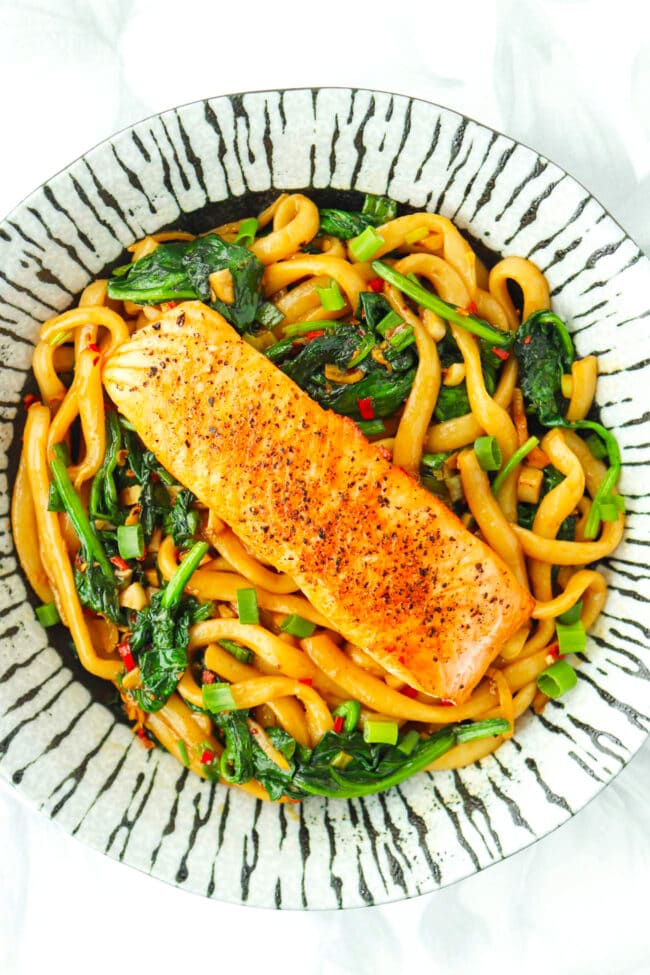
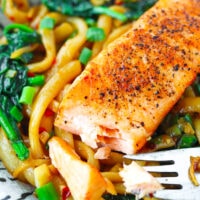
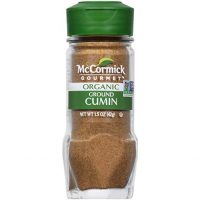
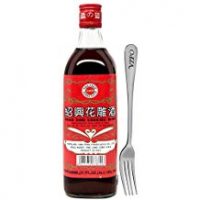



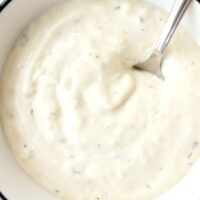

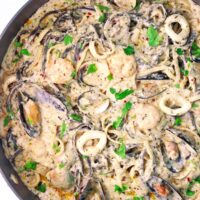

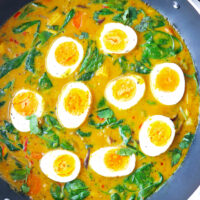
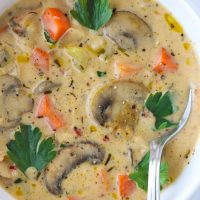


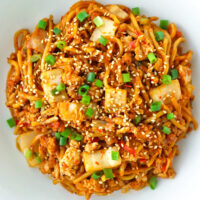
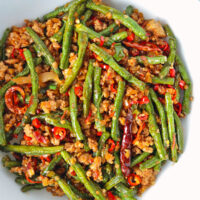

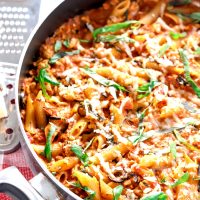
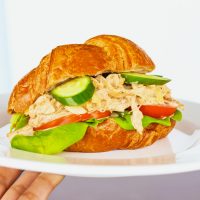

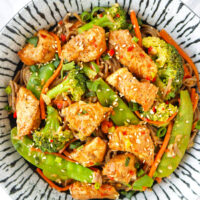
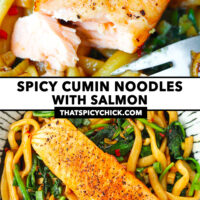

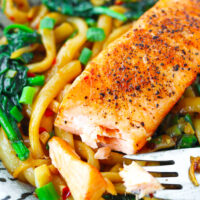
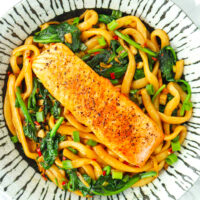




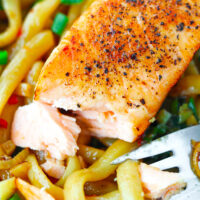
This recipe is PERFECTION! Right up my alley! All those wonderful spices, the chilies, the salmon! I love this!
Thanks, Mike! Hope you enjoy it!! 🙂